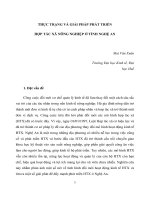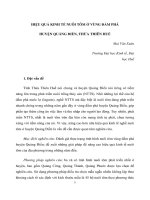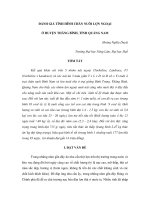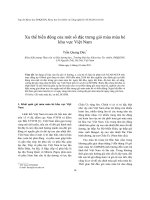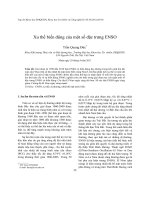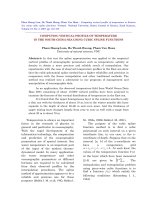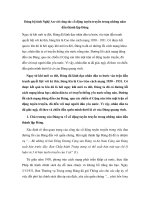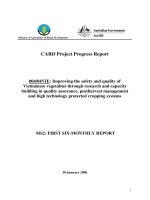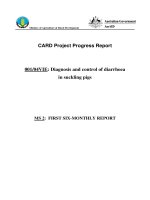Báo cáo nghiên cứu khoa học " Assessing the effectiveness of Farmer Field Schools for Implementation of Citrus IPM in Viet Nam - MS4 " potx
Bạn đang xem bản rút gọn của tài liệu. Xem và tải ngay bản đầy đủ của tài liệu tại đây (107.25 KB, 14 trang )
Ministry of Agriculture & Rural Development
_____________________________________________________________________
CARD Project Progress Report
036/04VIE
Assessing the effectiveness of Farmer Field
Schools for Implementation of Citrus IPM
in Viet Nam
MS4: SECOND SIX-MONTHLY REPORT
1
1. Institute Information
Project Name
Assessing the effectiveness of Farmer
Field Schools for Implementation of
Citrus IPM in Viet Nam
Vietnamese Institution
Plant Protection Department
Vietnamese Project Team Leader
Mr Ho Van Chien
Australian Organisation
University of Western Sydney
Australian Personnel
Debbie Rae, Oleg Nicetic, Robert
Spooner-Hart
Date commenced
January 2005
Completion date (original)
December 2006
Completion date (revised)
Reporting period
July to December 2005
Contact Officer(s)
In Australia: Team Leader
Name:
Debbie Rae
Telephone:
+61245701118
Position:
Research Program
Coordinator
Fax:
+61245701103
Organisation
University of Western Sydney
Email:
In Australia: Administrative contact
Name:
Gar Jones
Telephone:
+6124736 0631
Position:
Director, Research Services
Fax:
+6124736 0905
Organisation
University of Western
Sydney
Email:
In Vietnam
Name:
Mr Ho Van Chien
Telephone:
+8473834476
Position:
Director
Fax:
+8473834477
Organisation
Southern Regional Plant
Protection Centre
Email:
2
1. Project Abstract
Citrus is an important fruit crop in Viet Nam but productivity and production is impeded
by a range of pests and diseases. Integrated pest management (IPM) is widely recognised
as an effective and sustainable method of pest and disease control. Viet Nam has a well-
developed National IPM program of farmer participatory training and research using
Farmer Field Schools (FFS) which has trained more than 500,000 farmers in IPM
technologies for rice, vegetable, cotton, tea, soybean, peanut, and sweet potato crops. This
project has allowed the commencement of FFS training in citrus with 98 trainers attending
Master Training classes during April and May 2005 and these trainers subsequently
leading 24 FFS across 12 provinces in the Mekong Delta and the Central Coast regions of
Viet Nam. Farmers attended FFS weekly for 21 weeks and also participated in teaching
demonstration trials. Funding from outside the project budget allowed study tours for
farmers in the Mekong Delta to neighbouring provinces and project review workshops in
3 locations with representatives from all 12 provinces involved. Feedback from project
participants has resulted in modifications to the training programs for 2006 which will
improve their relevance and effectiveness.
2. Executive Summary
Viet Nam has a well-developed National IPM program that has resulted in more than
500,000 farmers being trained in IPM technologies for rice, vegetable, cotton, tea,
soybean, peanut, and sweet potato crops. Prior to this project no IPM training had
been conducted in citrus, despite it being an important fruit crop in Viet Nam. In the
first year of this project efficient planning and sustained efforts by all project
personnel has resulted in 98 master trainers being trained by 10 key scientists, and
these trainers successfully conducting 24 FFS in 12 provinces in the Mekong Delta
and Central Coast regions of Viet Nam. FFS involved weekly farmer meetings and
were conducted over 21 weeks. Trainers developed a schedule of activities during the
master training program and these activities were conducted simultaneously at all
FFS. Teaching demonstration trials were also implemented in 16 FFS. A farmer
practice baseline study was conducted at 15 locations and all farmers participating in
FFS completed a 52-question pre- and post-intervention survey. Results from the 727
pre-intervention surveys and 694 post-intervention surveys have now been analysed.
All components of the project logframe for 2005 have been completed. Two major
additional outputs to the project logframe have also been achieved and these will
significantly enhance the relevance of the project to both trainers and citrus farmers.
Study tours that allowed farmers to visit FFS in nearby provinces were funded by the
Australian Organisation and three review workshops that allowed very important
feedback about the training program in 2005 from participants were sponsored by
Bayer Viet Nam and SK Corporation Korea. At the project review workshops it was
agreed that the training program for 2006 should be modified to improve the
effectiveness and relevance of the training. Modifications include TOT being held
earlier in the year with more practical sessions and FFS starting earlier and finishing
later with less frequent sessions to allow all phenological stages of citrus from
flowering to harvest to be included in the program.
3
3. Introduction & Background
Citrus fruit is one of the major fruit crops in Vietnam (MARD 2004) and citrus
production is an important source of income for many Vietnamese farmers. However,
productivity and production of citrus in Vietnam is considerably lower than in
Australia and major citrus producing countries of the world such as Brazil and the
USA. It has been stated by MARD that “in general, citrus cultivation has not been
significantly developed over the past few years, largely because of the serious damage
of pests and diseases, especially greening disease (officially known as huanglongbing)
and therefore studies on their control methods, in combination with managing citrus
plantations and using advanced and intensive technology is a vital necessity” (MARD
2004).
The objectives of this project are to conduct Training of Trainers (TOT) for Master
Trainers in citrus IPM, for Master Trainers to conduct FFSs in their local region and
to assess the effectiveness of the FFS model in increasing farmer knowledge and
optimising pesticide use in citriculture. These objectives will contribute to the
empowerment of citrus farmers by enhancing their ability to make better-informed
decisions about pest and disease management through the adoption of IPM strategies
in citrus production in Viet Nam. Once a network of citrus IPM Master Trainers is
established and these trainers have gained essential practical experience in citrus IPM
training by holding at least one season long FFSs in citrus, Viet Nam should have a
significantly enhanced capacity to develop citrus IPM programs.
Multiple outputs from IPM training have been demonstrated in other cropping
systems. These include: farmer empowerment through increased knowledge of the
agro-ecosystem; the conservation of biodiversity and protection of the environment
through reduced pesticide application as a result of improved knowledge of pests and
diseases and more effective control measures; increased food security through
enhanced production; and protection of the health of farming communities and
consumers of fruit through reduced pesticide use in fruit production.
The key methodologies adopted in this project are participatory based learning and
action based research. The objective of both techniques is to fully engage participants
and allow them to direct the learning and research to best meet their needs.
4. Progress to Date
Implementation Highlights
Successful implementation of the program for 2005 has resulted in 98 trainers being
effectively trained and these trainers conducting FFS at 24 locations in 8 provinces in
the Mekong Delta and 4 provinces in the Central Coast region of Viet Nam (Table 1).
Two additional FFS were held in Tien Giang province using local government
funding, and 2 more have been pledged for 2006 . This is a very significant
4
endorsement of the relevance and usefulness of the training and it is expected that as
awareness of the FFS program in citrus increases, more locally FFS will be held.
Table 1. Location of FFS
Province Number of FFS
MEKONG DELTA
Tien Giang 3 + 2*
Dong Thap 2
Vinh Long 3
Can Tho 3
Tra Vinh 1
Hau Giang 2
Soc Trang 1
Ben Tre 3
CENTRAL COAST
Khanh Hoa 2
Binh Dinh 1
Quang Nam 1
Nghe An 2
TOTAL 24
* Funded by local government
FFS commenced in June and ran for 21 consecutive weeks using a schedule of
activities refined by the trainers during the master training program (see First 6-month
report). Key project scientists attended the opening of 16 FFS and during these visits a
farmer practice baseline study was conducted and teaching demonstration trials
implemented. Major findings from the farmer practice baseline study were:
¾ there are marked differences in the agro-ecological systems and citrus growing
practices used in the Mekong Delta and the Central Coast region (including
Nghe An province)
¾ farmers need to acquire more skills in recognising pests and diseases and
connecting these pests and diseases to the phenology of citrus trees
¾ spray application is mainly based on the use of knapsack sprayers
¾ the current economic situation and the impractical nature of the pest and
disease control strategies developed as part of ACIAR project CS2/2000/043
(high volume mineral oil sprays) and of a CIRAD project (imidicloprid
painted onto trunks) resulted in a new strategy being adopted that combines
elements of both strategies and current farmer practice (1 application of
imidicloprid followed by 2 mineral oil sprays per flush).
Details of the farmer practice baseline study and findings are provided in Annex 1.
In September the Australian Organisation agreed to financially support farmer study
tours in the Mekong Delta from sources other than the project budget, and a total of
$2494 was transferred to Viet Nam (Annex 2). Farmer study tours were conducted
from the 24-29
th
October with a total of 540 farmers from 18 FFS in 8 provinces in
the Mekong Delta visiting a FFS in another province. Farmers from seven provinces
visited Lai Vung district in Dong Thap province and farmers from Lai Vung visited
Cai Bei district in Tien Giang province.
5
The second additional objective of conducting review workshops in Can Tho, My Tho
and Vinh was achieved in November, with sponsorship from Bayer. At these meetings
the results of demonstration trials were reported by trainers, TOT and FFS training
programs were evaluated, feedback provided and revisions to the TOT and FFS
curriculum were agreed on (Annex 3).
Capacity Building
The institutional capacity of the PPD to facilitate farmer participatory training is high
and this project is further enhancing that capacity by addressing capability gaps in
relation to specific knowledge about citrus IPM. During the first year of this project it
has become clear that most of the necessary skills and expertise are available within
Vietnamese Universities and research institutions, but limited funds within local
institutions for travel result in poor access to this expertise. This project has provided
some funds to allow travel for Vietnamese personnel, but this is not sufficient and it is
recommended that more funds be allocated for travel within Vietnam in future
projects. The Australian Institution provided additional travel funds for Dr Nguyen
Thi Thu Cuc from Can Tho University to visit the Central Coast region of Vietnam as
described in the first 6-monthly report.
Forming linkages is also a critical component of capacity building and all efforts are
being made to build linkages between this project and other related projects. As part
of the farmer practice baseline study it was observed that phytophthora occurred in
every region and province visited and it appears that it could be as serious a problem
as Huanglongbing. However, farmers were generally unaware of the problem and
only a small component of the training included in the TOT related to phytophthora in
2005. As another CARD project 052/04VIE “Management of phytophthora diseases
in Vietnamese horticulture” is currently underway, UWS staff visited Professor David
Guest, the Australian project leader of the phytophthora project, to discuss the
problem of phytophthora in citrus. Professor Guest provided very useful information
on phytophthora and also lists of Vietnamese personnel involved in the phytophthora
project (Annex 4) and these were forwarded to the project leader, Mr Ho Van Chien
who facilitated linkages between the projects. Mr Duong Minh from Can Tho
University has now attended two of the three review meetings for this project held in
December 2005, and he will participate in TOT in 2006.
Training Programs
Training is a major component of this project and it has been conducted at two levels
during 2005. A total of 98 experienced PPD personnel received training in citrus IPM
and these trainers then facilitated a total of 24 FFSs in their local regions. In addition
to the FFS funded by the project, Tien Giang province conducted an additional 2 FFS
funded by the local government. Details of the training programs are discussed in the
“Implementation Highlights” section of this report.
6
Publicity
A finding of the pre-intervention survey was that the best way to disseminate
information to farmers through the media is by television as more than 90% of all
farmers have a television set in their own home. Every province in Vietnam has a
local television station and as 70% of the population live in rural areas, the level of
content relating to agricultural matters is high. Television reporters have been invited
to all major project events such as meetings and the opening and closing of FFS.
Numerous television reports about the project were broadcast in 2005, and details of
reports broadcast on National TV (VTV), Can Tho TV (CVTV) and Vinh Long TV
(VLTV) are provided in table 2. In July and September Tien Giang TV also hosted 60
minute sessions on the program “Farmers’ Bridge” where farmers called the TV
station with questions about the use of new technologies in citrus orchards and
scientists answered.
Table 2. Details of television programs reporting on project activities
Topic Program title Program
length
(mins)
Broadcast
date
TV
channel
“IPM” a new technology on
fruits commodity production
Specialist
topics of
Horticulture
30 Aug 31 VTV
Technologies for good taking
care of Citrus orchards at the
end of rainy season (use of
organic-fertilizer with
Trichoderma and quick
drainage)
Specialist
topics of
Horticulture
30 Nov 26 VTV
Citrus IPM - Experiences to
manage Citrus orchards by
pruning during rainy season
Specialist
topics of
Horticulture
30 Sept 15 VTV
Citrus IPM as the new method
to take care and manage quality
production of “Hong mandarin”
orchards pre-post havest for
“Marketing-oriented” in Tet
holiday
Farmers’
Bridge
60 Nov 17 VTV
IPM-The technology methods
applied in practice to reduce
costs (low inputs) of Citrus
production in Mekong Delta
Farmers’
Bridge
70 Nov 27 CVTV
Developing and using organic
fertilizer in sustainable
agriculture production
Farmers’
Bridge
70 Dec11 CVTV
Prevention and treatment water
flooding for Citrus orchards
Horticultural
Practices
15 Sept 15 CVTV
7
IPM - Enhancing effect of
productivity and improve
quality of citrus fruits by PSO
using
Farmers’
Bridge
120 Jul. 9
VLTV
IPM on Citrus program in Vinh
Long of PPD and WSU
Agriculture-
Rural Report
11 Sept 20
VLTV
Greening disease attacked on
King orange and need to have
IPM extension to prevent it
Agriculture-
Rural Report
10 Oct 25
VLTV
IPM - good control of root rot
diseases caused Fusarium
solani and stem root gummy
disease caused Phytophthora
spp.
Growth
technology
report
15 Nov 29
VLTV
IPM as a advance method for
Greening disease control on
King orange in Tra On district-
Vinh Long province
News 03.40 Nov 30
VLTV
The abstract of a paper entitled “Resilience of the Vietnamese citrus industry:
Vietnamese farmers learn to live with Huanglongbing” has been submitted to the 27
th
International Horticultural Congress to be held in Seoul, Korea from August 13-19,
2006 (see Annex 5).
Project Management
The Vietnamese Project Team Leader has demonstrated exceptional project
management skills and great resourcefulness. In addition to coordinating the training
of 98 trainers and successful completion of 24 FFS across 12 provinces in 2005, Mr
Ho Van Chien has initiated a range of activities outside the original scope of the
project. These include provision of hand lenses to all FFS, arrangement of study tours
allowing farmers in the Mekong Delta to visit citrus farms in different provinces to
their own, and the organisation of three review workshops in November 2006.
Funding for all these activities has come from outside the project budget. The
Southern Fruit Research Institute has also contributed greatly to the training program
providing 3 lecturers for the TOT program in 2005. This was not envisioned in the
project document and as such their time is not included as part of the in kind
contribution. The expertise of SOFRI researchers has greatly strengthened the scope
of training provided to trainers. The Australian Organisation has demonstrated great
commitment to the project and has facilitated training activities in Vietnam by
forwarding funds to the Vietnamese Institution before they have been received from
the funding organisation. The Australian Organisation has also provided additional
funds outside the budget to allow study tours for FFS participants in the Mekong
Delta. However, provision of additional funds is not sustainable given the difficult
economic situation that all Australian Universities are currently faced with. Oleg
Nicetic has contributed additional time to this project in Viet Nam when he travelled
to conduct research on a related SK Corporation funded project. All travel costs were
paid from the SK project.
8
5. Report on Cross-Cutting Issues
Environment
The focus of FFS is to increase the farmers understanding of the ecosystem and the
impact of human influences on it. This approach has the potential to reduce the
detrimental impacts of human activities on the environment. Farmers in the Mekong
Delta are reporting that IPM strategies they learned in FFS and have adopted on their
own farms have made it possible for them to raise fish in the canals between the citrus
trees. This is clear evidence of improved ecosystem health.
Gender and Social Issues
In the training of master trainers a total of 69 males and 29 females have been trained.
This proportion of males and females is reflective of the overall PPD trainer gender
balance. In the central coast region, the ratio of male to female farmers participating
in the FFS is similar to that of the trainers. However, in the Mekong Delta region the
proportion of females participating in FFS is lower. This may be related to traditional
roles of women in the delta being more oriented to animal husbandry.
Representatives from VACVINA, the Women’s Union and the Farmers Union are
always invited to project planning meetings and more input is being sought from them
in relation to project gender and social issues.
6. Implementation Issues
Issues and Constraints
An important constraint of the project is limited local resources available to
Vietnamese scientists, researchers and trainers to allow them to travel outside their
local region in order to seek or provide expertise and exchange information. While
there are some inherent barriers to the exchange of information between regions, such
as use of different dialects of Vietnamese, these are relatively minor. Major
constraints are the very small local budgets for travel between institutions, and even
for telephone calls within Viet Nam. Travel by local bus and train is relatively cheap
compared to air travel, but poor roads and frequent stopping make such travel time-
consuming and physically taxing. The provision of additional funds for Vietnamese
project personnel to undertake air travel between regions would greatly facilitate the
establishment of professional relationships which could then be maintained using
communication by email.
Exchange of information between farmers except on a very local scale is also limited.
Farmer study tours were funded from outside the project budget to facilitate exchange
of information between farmers from different provinces. The study tours were
greatly appreciated by farmers, and trainers attending the review meetings reported
that farmers wanted more study tours. Additional sources of funding are being
investigated, but at this stage the likelihood of obtaining funding is not known.
9
Options
At the review meetings the option of increasing the number of FFS by 50% (from 24
to 36) from 2005 to 2006 rather than an increase of 100% (from 24 to 48) as planned,
in order to increase the resources available for each FFS, was suggested. This was not
considered a viable option, because of the extremely high demand for FFS. Additional
sources of funding to supplement project activities will continue to be sought.
Feedback from the review workshops held in November consistently indicated the
need to modify the training programs. Participants requested more practical
components to the TOT and for the FFS to run for longer to allow all phenological
stages of citrus from flowering to harvest to be included in the program. Key scientists
involved in the delivery of TOT will be asked to restructure their teaching program to
include a lecture session on the morning and a practical session in the field in the
afternoon. The agreed strategy to extend the FFS program from flowering to harvest
was to retain 21 teaching sessions as in 2005, but for these sessions to be held less
frequently and concentrated around the important phenological stages of the citrus
trees and their pests and diseases.
7. Conclusion
High levels of enthusiasm for this project, efficient planning, open communication
between project personnel and sustained efforts have resulted in all components of the
project logframe for 2005 being completed. Additional objectives were also achieved
using funding from outside the project budget. Review meetings provided invaluable
feedback from project participants and training programs will be modified in 2006 to
improve their relevance and effectiveness.
List of Annexes
Annex 1. Farmer practice baseline study
Annex 2. Costs and funds provided for farmer study tours in the Mekong Delta
Annex 3. Review workshop outcomes
Annex 4. Phytophthora project participants
Annex 5. Abstract of paper to be presented at the 27
th
International Horticultural
Congress in Seoul, Korea
10
Annex 1
Farmer practice baseline study
From 6
th
June to 19
th
June project personnel including Oleg Nicetic, Ho Van Chien,
Dr Nguyen Thi Thu Cuc, Dr Tran Van Hai and Mr Cuong visited 16 FFS in the
Mekong Delta and the central coast regions of Viet Nam (Table 1). At each location
the farmer who hosted the FFS demonstration experiment on his land was
interviewed, and discussions were held with other farmers participating in the FFS
about their citrus growing practices with particular emphasis on pest and disease
control. A local agricultural chemical shop was also visited and the owner or manager
interviewed to determine the dominant pesticides that are sold to local citrus growers.
Information collected from these interviews complements detailed information
collected from each of the participating farmers in pre- and post intervention surveys.
The major aims of these interviews were to:
¾ obtain an overview of current citriculture practices throughout the study area
¾ document spray application practices and pesticide usage
¾ determine if IPM strategies based on mineral oil (major focus of ACIAR
project CS2/2000/043) and imidicloprid (major focus of CIRAD research
program) are feasible to implement given farmers current practices and their
economic circumstances
¾ determine the major gaps in the knowledge of farmers so that these topics can
be included in the FFS.
Findings
Dominant citrus species
In the Mekong Delta mandarin (King and Tieu varieties) are the most commonly
grown species, but the area planted with pomelo is expanding rapidly (Table 1). In the
Central Coast, pomelo is by far the most dominant species while in Nghe An oranges
are most commonly grown.
Orchard layout
In most provinces in the Mekong Delta, farmers use very high density plantings of
between 2000 and 4000 trees per hectare (Table 2). Two rows of trees are usually
planted on mounds between canals. The exceptions are Tien Giang and Dong Thap
provinces where there are between 800 and 2000 trees per hectare. Tree densities are
markedly lower in the central coast region, with between 330 and 400 trees per
hectare while in Nghe An province there were between 600-700 trees per hectare.
The practice of high-density plantings in the Mekong Delta has possibly arisen as a
strategy to allow farmers to maintain a relatively continuous income from citrus on
1
their small holdings, even though trees are consistently being killed by huanglongbing
(citrus greening disease) or other diseases. When the trees in an orchard reach an age
of 4-6 years, farmers interplant the orchard with young seedlings. When the older
trees reach an age of 10-12 years they are removed and more seedlings planted
resulting in continuous production from the same orchard. This is a very effective
strategy, but more comparative analysis needs to be conducted to determine the most
effective planting density. It is clear that planting densities of 4000 trees per hectare
are not sustainable and the trees are so close together that it is not possible to apply
pesticides or even harvest fruits effectively. However, within the range of planting
densities from 1000 to 2000 trees much more study is necessary to determine which
plant density generate more net income and is more sustainable from soil and soil
born disease management point of view. From our observation there is tendency that
smaller farmers with an area of only a few thousand m
2
tend to have higher density
plantings while farmers with 1 or more hectares of land tend to plant less densely. Net
income on larger farmer is higher but that could be attributed to factors other than
planting density such as higher fertiliser input, better pest and disease control, use of
motorised sprayers and disease free seedlings. Scientific questions that should be
answered in the future are if there are different optimal planting densities that are
related to the size of the farm land.
To facilitate discussion about the optimal planting density, bus trips were organised
for FFS participants from all provinces that practice high density planting to Dong
Thap province to experience and exchange their experience with farmers that practice
lower density planting.
Dominant pests and diseases
Farmers have great difficulty identifying pests and diseases, and in many cases are
unable to separate damage caused by pests or diseases. In most cases the farmers
intervene when it is too late to provide effective control of the causal agent. A typical
example of late intervention is with leafminer. Farmers also apply pesticides
unnecessarily to visible pests that do not cause economic damage. A typical example
of this unnecessary application of pesticides is with aphids.
Overall in the Mekong Delta farmers nominated mealybugs on roots as the major
problem (Table 3). This mealybug was previously an unimportant pest as it was
naturally controlled when trees were flooded. Better flood management has allowed
mealybug populations to develop year round without natural control and it is now
considered a serious problem by farmers. The mealybug has not yet been identified
and as such no effective control measures are available. However, as there has been
no objective evaluation of damage caused by this pest it is not clear if it really is a
serious pest or if it is of concern to the farmers because it is a new phenomena.
Further investigation as to the importance of this pest is needed in the second year of
the project. Other major pests nominated by farmers include leafminer, psylla and
mites (Table 3). Although leafminer does not appear to cause economic damage, it is
of concern to the farmers because damage appearing on leaves after leafminer have
pupated and moths hatched is very visible. Sprays are often applied at this stage,
which is too late for control. Farmers are aware that huanglongbing is transmitted by
psylla, but except for Dong Thap province it appeared that this pest was not
2
effectively controlled because sprays were applied too late. However it appears that
farmers in the Mekong Delta have learned to live with huanglongbing by continually
replanting their citrus orchards as discussed previously. Unfortunately most farmers
use marcotted planting material. Previously much of this material was of unknown
origin, purchased from unauthorised salespeople selling from boats, but farmers
indicated that more recently they are either marcotting trees themselves or purchasing
from neighbours to ensure that planting material was taken from healthy vigorous
trees without symptoms of disease.
In the Central Coast (not including Nghe An) psylla and huanglongbing were not
considered a problem by farmers, and neither were visible on trees. Borers and
leafminer were the only pests considered important by farmers. Borer damage is
serious, but the pest has not been identified and no effective control strategy has been
developed to date. More emphasis will be placed on this pest in the second year of the
project. As in the Mekong Delta, leafminer is not an economic pest, but farmers apply
sprays after damage has occurred.
In Nghe An province mites and phytophthora were considered the major problems by
interviewed farmers, but huanglongbing was observed to be more serious and
widespread than in any other province visited. Farmers are aware that psylla transmit
huanglongbing, and the use of disease free material is greater than in southern
Vietnam, but there is a general misconception that controlling psylla on the spring
flush (that bears the fruit in the following autumn) is sufficient. In order to prevent
transmission of huanglongbing, psylla need to be controlled year round on all flushes.
This point will be emphasised in the training in the second year of the project.
Phytophthora was observed in every region and province visited and although it
appears to be as serious a problem as Huanglongbing, most farmers were unaware of
the disease. Much greater awareness of the disease and effective methods to manage it
are necessary and achieving this will be a focus of the training in 2006. As another
CARD project 05204VIE “Management of phytophthora diseases in Vietnamese
horticulture” is currently underway, UWS staff visited the Australian project leader of
the phytophthora project Professor David Guest to discuss the problem of
phytophthora in citrus. Linkages were formed between the projects by connecting
participating Vietnamese personnel and Mr Duong Minh from Can Tho University
has now attended two of the three review workshops for this project held in
November 2005.
Pesticides were generally not overused in the regions and provinces visited. However,
timing of spraying and the type of pesticide used needs to be optimised. In Nghe An
province the number of sprays can be reduced, but in the Central Coast the number of
sprays needs to be increased for effective pest and disease control. Farmers
predominantly used cheap products that were older generation pesticides (Table 3).
Use of mineral oil was found to be negligible which is disappointing considering the
investment made by Caltex and through previous ACIAR and CARD projects. The
main reason for low uptake of the use of oil is phytotoxicity experienced by many
growers. Phytotoxicity was due to many factors including high temperature and
humidity, misuse of oil by farmers mainly through incompatible mixtures, too
frequent sprays promoted by researchers and susceptibility of certain varieties of
mandarin. Beside problems of phytotoxicity the efficacy of oil was not sufficient in
3
many cases due to poor application methods. This baseline study revealed that except
for Dong Thap and Nghe An province, knapsack sprayers are used by the vast
majority of farmers (Table 3). Mineral oil is an important component of this project,
but it is only part of a program that will include a range of other pesticide
(imidicloprid) and biological control methods. Use of weaver ants (Oecophylla
smargdina) as a biological control agent is widespread. The excellent awareness of
biological control by farmers is an important base which can be built on to develop
other biological control technologies, such as using Trichoderma and compost to
better manage phytophthora.
Conclusions
It is clear from the information collected from interviews and observations that there
are marked differences in the agro-ecological systems and citrus growing practices
used in the Mekong Delta and the Central Coast region (including Nghe An province).
Although within this project it is not possible to develop 2 independent training
programs, it is important that training programs for both trainers and farmers and the
recommendations developed for pest and disease management take into account the
differences between the 2 regions.
Farmers need to acquire more skills in recognising pests and diseases and connecting
these pests and diseases to the phenology of citrus trees. In 2005 the IPM strategies
trialled and taught were based on presumptions of ACIAR CS2/2000/043 and CIRAD
projects. From farmer and trainer feedback it was concluded that neither strategy
could be implemented in the current farmer practice and economic situation because
of impracticalities and high cost. The new strategy to be adopted in 2006 combines
elements of both projects but is based also on current farmer practice which
acknowledges that huanglongbing cannot be eradicated but viable production still can
be achieved. The new strategy is simple, follows the flush cycle and will use one
application of imidicloprid per flush followed by 2 mineral oil sprays at a
concentration of 0.25%. Other pesticides will be used as needed based on the results
of monitoring.
Spray application is based on the use of knapsack sprayers with limited use of home
made motorised sprayers consisting of a petrol driven pump, a barrel to hold the spray
mix and a long hose fitted with a wand and an adjustable hollow cone nozzle.
Adoption of motorised sprayers is slow and will probably continue to be slow on
smaller properties because a knapsack is sufficient and can be operated by one person
unlike the motorised sprayer which requires two operators. The quality of knapsack
sprayers is very variable and unfortunately only a small number of growers use
quality metal knapsack sprayers that can achieve reasonable pressure. Very cheap
knapsacks made of low quality plastic are commonly used. Efforts should be made
within the project to educate the farmers about the benefits of good quality knapsack
sprayers
4
